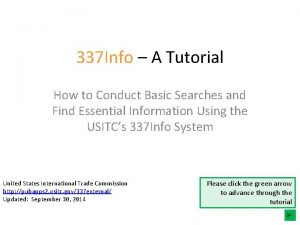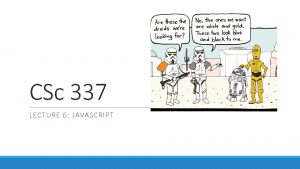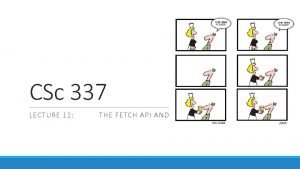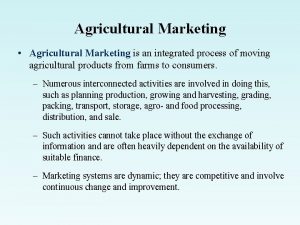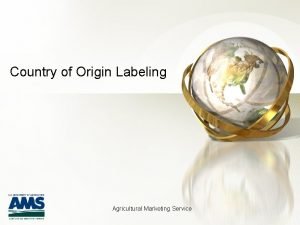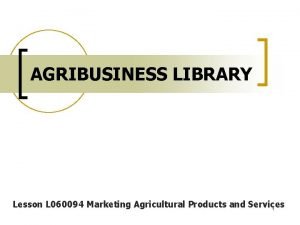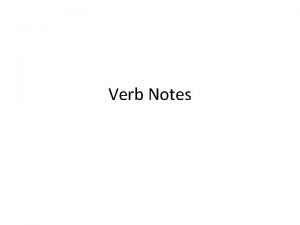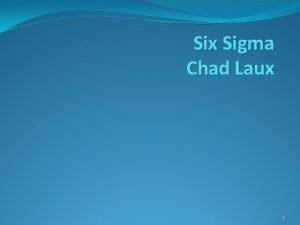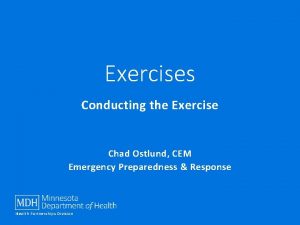ECON 337 Agricultural Marketing Chad Hart Associate Professor






















- Slides: 22

ECON 337: Agricultural Marketing Chad Hart Associate Professor chart@iastate. edu 515 -294 -9911

Futures Markets Ø Organized and centralized market Ø Today’s price for products to be delivered in the future Ø A mechanism of trading promises of future commodity deliveries among traders

Futures and Options Ø Market tools to help manage (share) price risks Ø Mechanisms to establish commodity trades among participants at a future time Ø Available from commodity exchanges / futures markets

Agricultural Futures Markets ØHas some unique features due to the nature of agricultural businesses ØSupply comes online a few times during the year ØSo at harvest, supply spikes, then diminishes until the next harvest ØProduction decisions are based price forecasts ØPlanting decisions can be made a full year (or more) before the crop price is realized ØUsers provide year-round demand ØLivestock feeding, biofuel production, food demand

Futures Market Exchanges ØCompetitive markets ØOpen out-cry and electronic trading ØCentralized pricing ØBuyers and sellers are both in the market ØRelevant information is conveyed through the bids and offers for the trades ØBid = the price at which a trader would buy the commodity ØOffer = the price at which a trader would sell the commodity

CME Group Øhttp: //www. cmegroup. com/ ØProducts ØAgricultural commodities ØCorn, soy, cattle, hogs, etc. ØEnergy ØCurrency ØMetals ØWeather ØOthers

Futures Contracts Ø A legally binding contract to make or take delivery of the commodity ØTrading the promise to do something in the future ØYou can “offset” your promise Ø Standardized contract ØForm (weight, grade, specifications) ØTime (delivery date) ØPlace (delivery location)

Soybean Futures Ø Form Ø 5, 000 bushels ØNo. 2 Yellow Soybeans (at price), No. 1 Yellow soybeans (at 6 cents over price), and No. 3 Yellow Soybeans (at 6 cents under price) Ø Time ØContract months: Sept, Nov, Jan, Mar, May, July, and August Source: CME Group

Soybean Futures Partial listing of delivery points Source: CME Group Rulebook

Delivery Points Corn Soybeans Wheat Source: Irwin, Garcia, Good, and Kunda, 2009 Marketing and Outlook Research Report 2009 -02

Futures Contracts Ø No physical exchange takes place when the contract is traded (no actual commodity moves) Ø Payment is based on the price established when the contract was initially traded (prices can and will change before delivery is taken) Ø Deliveries can be made when the contract expires or the offsetting futures position must be taken to settle up Ø Deliveries occur on less than 5 percent of the traded contracts

Market Positions Ø You can either buy or sell initially to open a position in the futures market Ø“Make” a promise to make or take delivery Ø Do the opposite to close the position at a later date Ø“Offset” the promise (and no commodity changes hands) Ø Trader may also hold the position until expiration and make or take physical delivery of the commodity

Trading Futures Contracts Ø All trades through a licensed broker Ø Brokerage house has a “seat” at the exchange and is allowed to trade ØRepresented “on the floor” to exercise trade ØLocal broker to initiate transaction and manage account with client ØFull service and discount brokers

CME Group Øhttp: //www. cmegroup. com/ ØOpen, High, Low, Last Price ØSettlement Price ØVolume ØOpen Interest ØDaily Limits

Terms and Definitions Ø Basis ØThe difference between the spot or cash price and the futures price of the same or a related commodity. Ø Bear ØSomeone that thinks the price will decline Ø Bull ØSomeone that thinks the price will increase

Cash vs. Futures Prices Iowa Corn in 2016 The gap between the lines is the basis.

2016 Basis for Iowa Corn

Terms and Definitions Ø Clearing House ØThe division of the futures exchange through which all trades made must be confirmed, matched and settled each day until offset or delivered. Ø Commission ØFor futures contracts, the one-time fee charged by a broker to cover the trades you make to open and close each position.

Terms and Definitions Ø Long position ØA position in which the trader has bought a futures contract that does not offset a previously established short position. Ø Short position ØA position in which the trader has sold a futures contract that does not offset a previously established long position.

Going Short Sold Dec. 2017 Corn @ $3. 8675 What type of trader (bull or bear) would go short? What events would send prices in a favorable direction?

Going Long What type of trader (bull or bear) would go long? Bought Dec. 2017 Corn @ $3. 8675 What events would send prices in a favorable direction?

Class web site: http: //www 2. econ. iastate. edu/~chart/Classes/econ 337 /Spring 2017/ Have a great weekend!
 Promotion from associate professor to professor
Promotion from associate professor to professor Stars dogs plowhorses and puzzles
Stars dogs plowhorses and puzzles 337 form example
337 form example 337 form example
337 form example 337 form example
337 form example 337info
337info Adxl 337
Adxl 337 Csc 337
Csc 337 Csc 337
Csc 337 Agriculture marketing process
Agriculture marketing process What is agricultural marketing circle?
What is agricultural marketing circle? Scope of agricultural marketing
Scope of agricultural marketing Marketing mix of agricultural products
Marketing mix of agricultural products Chad b swim helping verbs
Chad b swim helping verbs Vtg gps
Vtg gps Ilan raymond
Ilan raymond Chad ulven
Chad ulven Wiu map
Wiu map Sigmachad
Sigmachad Chad topaz
Chad topaz Chad ostlund
Chad ostlund Chad posner
Chad posner Uiaddi
Uiaddi





